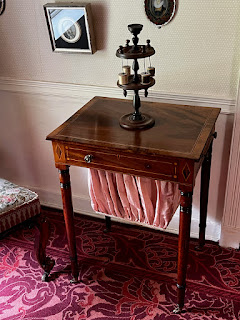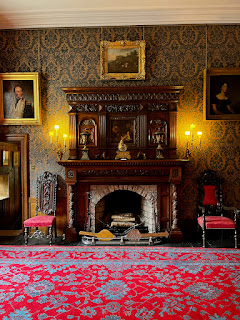Although the title does signify part of today's adventures, our search for stones were actually at the end of the day, on the way home from exploring some fascinating historical buildings.
But, I'll jump ahead and show you what we found just in case your interest in castles might be waning. I know that it might seem to get old following the castle trail, but we personally find each one to offer some interesting insight to Scottish History and haven't been bored with one yet!
But here's what we found today on the "Pictish" trail.
The first is actually a stone right outside the Leith Hall Gardens.
A few miles away, in a field with sheep grazing in the distance, stands the Picardy Stone.
In order to access viewing, one must climb up and over the fence into the field.
Just be careful not to touch any of the wires, as you might just get a shock! And, luckily, we didn't have to encounter any furry friends on our quest.
Here's an idea of the size.
You can easily spot all of the ornate carvings in the stone.
Venturing just a little while down yet another tiny road, one comes across the Maiden Stone. This one was easy access with a little parking lot off the road. No sheep involved.
A mirror and comb can be clearly seen on the bottom of this stone. The other suggested inscriptions are a bit more difficult for me to decipher.
Here is the back:
And, finally, nestled in a small park among houses in a regular neighborhood, stands the Brandsbutt Stone.
Pretty amazing that something over 1400 years old can still be so well preserved. Kudos to Historic Scotland for emphasizing the importance of protecting these treasures for future viewing. There were several more in the area, but we decided that we'd had enough exploring for now.
Since I jumped ahead in my enthusiasm, let's go back to the events of the day.
First stop was to Fyvie Castle. This amazing structure has been standing here since the early 1200's.
As typical with many of these older structures, there is an original building with subsequent additions added on over time. This one has some interesting statutory perched upon the turret rooftops.
Each of the round sections is topped with a different one.
There was a link between this castle and Haddo house which we toured yesterday. If you recall the inscription in the front stones that featured the name Anne Gordon, this is where she hailed from, and it is only 5 miles in distance from Haddo house. The same portrait that hung in Haddo was also featured here, but the colors are much more brilliant.
The house had several famous residents over time some of whom include Robert the Bruce's sister, Margaret; Charles I, who was brought to the house as a child for safety during the plague. His godfather was Alexander Seton, who had lived in the castle at that time.
It's easy to imagine the castle's environment in that time period from some of the items in the original part of the castle.
The steps are the widest of any castle in Scotland. They are also shallow in depth, and it was noted that the family would race horses up these steps into the dining room.
Ceilings featured various crests of arms ornately decorated.
Alexander Seton's godmother was Mary Queen of Scots and her portrait hangs in the corner of this room. The family were strong Jacobites and this room was planned with a "priest's corner" hidden in the paneling, for easy exit when necessary.
There were many paintings by Raeburn hanging on the walls. This is Charles Gordon painted in 1790.
In 1885, Alexander Forbes-Leith purchased the castle. He was married to an American woman born in Missouri and made his fortune in the steel industry. His wife's portrait is displayed within the ornate fireplace at the one end of the dining hall.
The castle was brimming with many items collected by the family over the years.
Room after room featured ornate ceilings and preserved treasures.
A music room was added to the castle by the Leith family. Their portraits hang above the large fireplace. Tapestries which had been purchased by Forbes Leith specifically for the castle, adorn the walls. They add to the acoustic touch to the room.
Looking up, there were so many beautiful crests that caught my eye.
Finally, I want to share two portraits. Aren't these ladies exquisite?
The gardens associated with the castle are beautifully laid out, and are not so much for display as for an aesthetic presentation of practical plants for produce.
The garden was brimming with green beans, purple beans, squash, rhubarb, turnips, beets, onions and chives, not to mention the apples bursting on the trees.
And, it appears that the staff might be slacking on checking the growth of those zucchinis!
We spotted some even larger ones still hanging on the vines. No squash bugs here to spoil growth!
Moving on, we stopped to visit Leith Hall. (No connection with Forbes Leith of Fyvie Castle.) Built in the 1600's, it had originally been a fraction of the present day size.
The turrets had been added on at a much later date.
The house had a fascinating history regarding its inhabitants, and it is difficult to recall many of the details. But one thing of note is that the same family lived within the walls for 350 years until it was bequeathed to the National Trust.
One of the owners of the estate, was keen on "recycling". One room had wall and ceiling paneling that came from church pews that he had purchased. Had it not been pointed out, I'm not sure that I'd have noticed. The fireplace here, was made using bedposts on the sides. Pretty clever, don't you think?
There were dozens and dozens of embroideries hanging on the walls, all stitched by one of the ladies of the house who found herself quite bored living in this part of the country.
This would have been her stitching table.
I was amazed at how well preserved they were.
She must have spent all of her days stitching, and we were told that she eventually lost her sight due to the low light conditions. But she certainly did manage to complete an unbelievable amount of projects which was obvious when walking through hallways that featured her many works.
The last laird of the house was living in Australia when he inherited. He returned to Scotland to fulfill his duty as heir, and married a woman from Ireland. She brought her fireplace with her, and it was added to the music room that stands in Leith Hall at present day.
Shortly after she left Ireland, with the mantlepiece, the castle where she had lived burned down, so the only item remaining stands now here at Leith Hall.
Finally, one of the residents had worked as a spy during the Napoleonic wars, had been captured, but hardly treated as a prisoner as he was befriended by his captives. After his release, he was gifted this original scarf belonging to Napoleon himself, and it is among the collection of items in the house.

The tour lasted well over 90 minutes, as we heard stories of how the monies had been squandered by an 18 year old inheritor, then saved by a Jacobite uncle who had managed to flee from the battle of Culloden. He was 7 foot 2 in height, yet managed to hide in plain sight of the British by using the ploy of having scarlet fever. He lay in a bed, and put a cap on his head, cap on his feet, and covers over the rest of him. The servants told the British soldiers to be wary because there were two sisters in bed with the disease, and they wouldn't want to contract it. They peeked in, saw what they presumed were two heads in on opposite sides of the bed, and left without question. This giant of a man managed to escape capture for 6 years at which point he was officially pardoned, and returned to Leith.
How's that for a great story?
We returned to our B&B in Cruden Bay, and took a quick walk out to Slains Castle, which is a ruins that stands along the North Sea, just about half a mile from where we are staying.
It looms near the rocky cliffs offering some stunning views of the cliffs nearby.
It is said that it was the inspiration behind the novel, Dracula, written by Bram Stoker, who used to holiday here at Cruden Bay in the Summer.
And, at that, I'll call it a day!
Hope you enjoyed today's adventures!



























































No comments:
Post a Comment